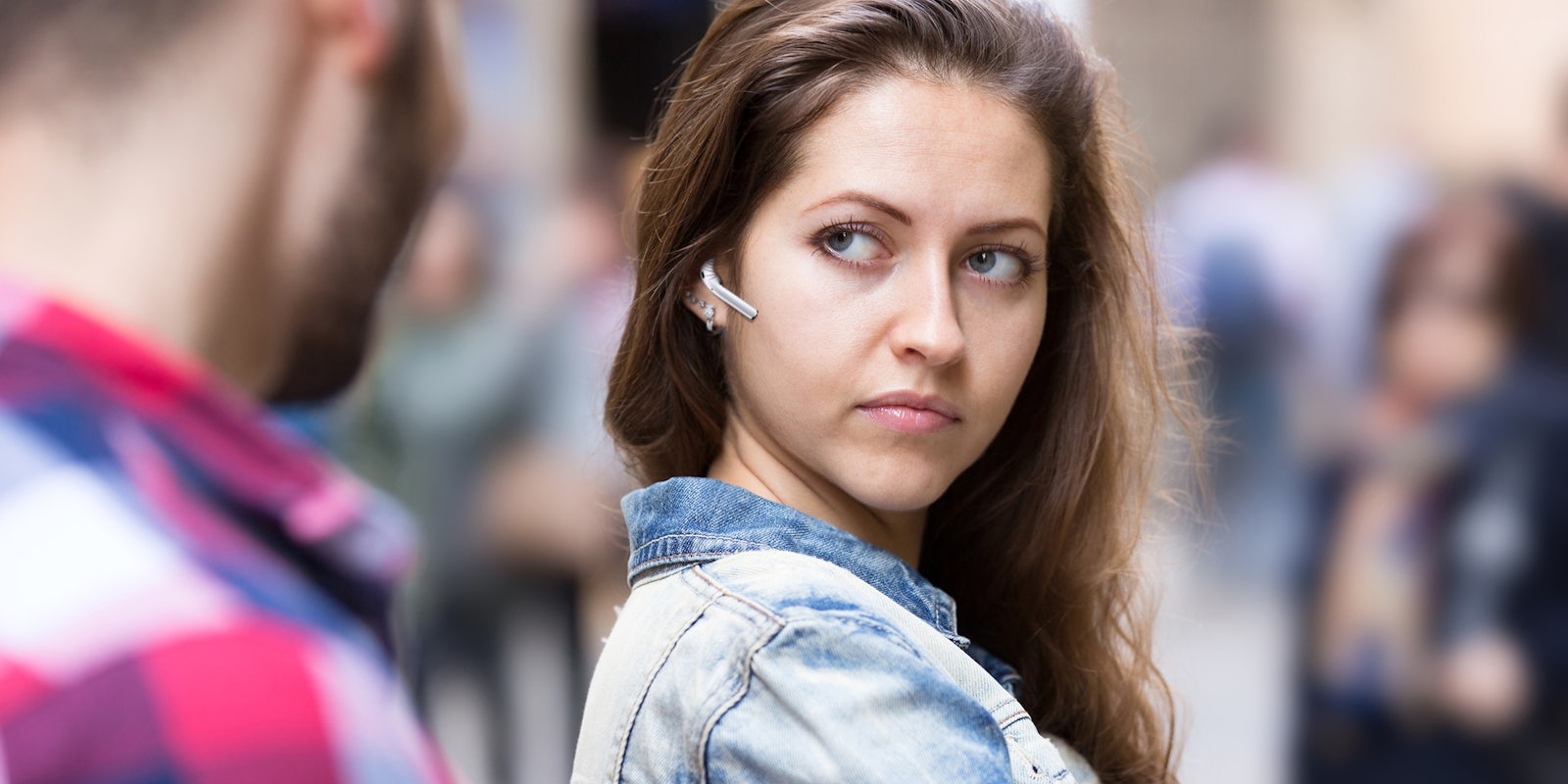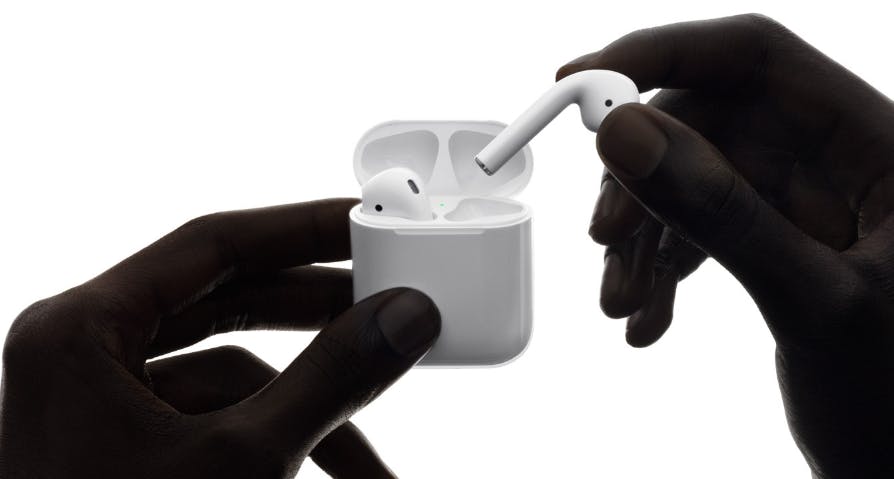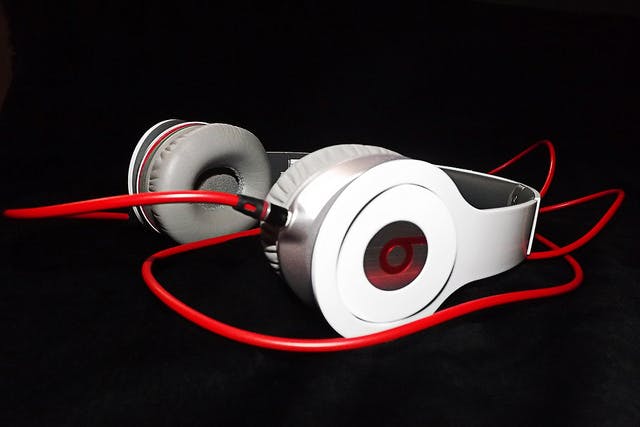One of my best friends likes to joke that we would have been friends earlier had it not been for my gigantic headphones. I bought them mainly for sound quality and comfort, but realized they were serving as unintentional armor against the outside world. Sometimes this was bad, like when I couldn’t hear honking cars or potential best friends saying hi to me on campus, but ultimately, it was a feature, not a bug. If people were too intimidated to talk to me, then it meant men were too intimidated to talk to me.
Headphones have hit the media conversation in two big ways in the past month. The first is with Apple’s announcement of the new AirPods, the wireless earbuds that will be far-less noticable to others (and incredibly easy to lose). The other was a now-deleted post from the Modern Man titled “How to talk to a woman wearing headphones,” in which the author, Dan Bacon, assumes “if a woman wearing headphones is single and hoping to meet a boyfriend (or even a new lover), she will almost always be happy to take off her headphones to give you an opportunity to create a spark with her.”
Bacon’s post was widely ridiculed, especially by women, who noted that most of Bacon’s advice boiled down the dangerous tip of “don’t let her say no.” But it also illuminated a secondary use of headphones that women have been utilizing for years—as protection from street harassment.
This knowledge is something a lot of women and non-binary people learn early on. “I always wore headphones, starting in high school, if I was walking to the bus or subway alone—creeps can be very into young girls in school uniforms,” 27-year-old writer Pilot Viruet told the Daily Dot. “But I got really obsessive with it when I started working retail in SoHo because the men there were, like, extra aggressive for some reason.”
Viruet often listens to music and says that helps them ignore most catcalls and comments. “There is the ‘normal’ catcalling that I can tune out and then there are the threats and insults when I don’t respond. Or the fucked-up speculation about my gender, and all that stuff that I can’t really deal with when I’m just trying to get to work. And if I hear it, it’ll sometimes derail my whole day,” they said.
Others just use headphones for show. “Half the time I wear headphones, there’s nothing playing,” Rachel Pendergrass, a 26-year-old writer and performer, told the Daily Dot. “Sometimes, if my phone is off, I just ‘plug’ the headphones into my pocket. They give me at least a little bit of a barrier.” Teacher Melissa Petro does the same when she goes to the gym. “They put a barrier between you and the dude. You can pretend you didn’t hear the guy, or that you don’t realize he was trying to talk to you.”
Whitney Johnson, a 30-year-old who works in publishing, said she wears headphones to avoid catcallers, but that she won’t play music to remain aware of her surroundings. She didn’t always use them for protection, but that “it grew out of wearing them to listen to music on my commutes and realizing how much less I was bothered the days I had them on than when I didn’t.”
This unspoken social contract—I’m listening to music, I’ve got a podcast running, my mind is engaged and I’m not here for conversation—is what women and non-binary people are using to their advantage. Because unless you’re the guy who wrote about talking to a woman wearing headphones, you probably understand that trying to strike up a conversation with someone wearing headphones is rude. Sure, you may need to ask someone to remove them to ask for quick directions, but something plugging up your hearing holes is a signal that the wearer is off-limits.
Critics will often say that if a woman doesn’t want to engage with a man, she can simply say “no.” However, repeated incidents of women being hurt or killed for saying no or ignoring their harasser show that it’s not that simple. Viruet said that when they wear headphones, “I can tell guys will often assume I didn’t answer them because I couldn’t hear them, and they’ll sort of shrug—instead of when I don’t answer without visible headphones and they switch to anger and keep yelling at me.”
“I know, 100 percent, that if I ignore somebody and pretend not to hear them talking to me, the likelihood that they’ll believe me (and that other people won’t think I’m being a snob for not replying) is much higher” with large headphones on, beauty editor Sam Escobar told the Daily Dot.
The act of wearing headphones is as much about the performance of wearing them as their existence. Many of the people I interviewed mentioned doing things like adjusting the cord, or taking their headphones off and putting them on again, to make it clear to anyone watching that they are (or look like) they’re busy listening to something.
However, these tactics can backfire. While many men may lay off if they assume their target hasn’t heard them, others will double-down.
“When I’m wearing headphones, guys will often assume I didn’t answer them because I couldn’t hear them. When I don’t answer without visible headphones, they switch to anger and keep yelling at me.”
This has happened recently to Chloe Rickert, a woman in her 20s living in New York. She detailed to the Daily Dot two recent instances in which men waved their hands in her face, grabbed her arms, and followed her for blocks after she either didn’t hear them or refused to respond to them while wearing headphones.
“I didn’t hear him the first time,” he asked her the time, she says, “so he grabbed me and raised his voice. Despite my surprise and fear, I told him the time and kept walking. He then proceeded to follow me, screaming that he just wanted to know the time. I tried to ignore him and keep walking, so he quickened his pace to walk right next to me and try to make eye contact, and ask me how my day was going.” She eventually had to run away and threatened to call the police.
Because women fear incidents like this, they often put a lot of thought into the design of their headphones, in the hopes that at least a few of these interactions can be avoided. Rickert says, “I purposefully bought big white headphones after years of earbuds because I thought they would give off the impression that I didn’t want to be bothered by strangers.” Viruet does the same, buying big headphones in colors like white or blue that can be seen from afar. Johnson prefers earbuds but seeks out brighter colors so that the cord is visible.
When I asked the people I interviewed about the AirPods and similar designs, most of them said they wouldn’t suit their life. “iPhone earbuds never stay in my ears, but I’ve had to use them a few times and they make me feel more exposed somehow. Like, they’re way less of a shield than giant headphones,” says Viruet. “That’s definitely an issue,” said Pendergrass about AirPods’ size.
The Daily Dot hasn’t heard back from Apple about why it decided on its AirPod design, which is planned for release at the end of October, but the trend for wireless or easily hideable headphones has been growing. Samsung, Beats, and Skullcandy all make wireless earbuds. And though AirPods have also been ridiculed for their appearance and how easy it’s going to be for sea turtles to choke on them when they are inevitably lost and flushed to the ocean, they’re still designed by Apple. It’s not hard to imagine other companies following its lead.
It’s not the headphone industry’s job to make sure people feel safe from street harassment; companies are here, at best, to provide a product that is comfortable and makes music sound good. However, it should be noted that just 32 percent of Apple’s workforce is women. And while Apple doesn’t specify the gender breakdown between departments on its site, a report from Invision shows that men outnumber women in design fields three to one. A lack of women in the industry could also mean a lack of perspectives about how lots of people practically use headphones in everyday life.
Rie Ma, 29, says no matter what the design, she’s doesn’t expect headphones to keep her safe. “Even though I use them to discourage contact, I don’t have a ton of faith in them, so mostly I count on my walking really fast and ignoring someone.” She describes the headphones as an added “safety blanket” on top of the tough public demeanor she’s had to cultivate.
For that reason, Ma said she’d probably be fine with AirPods. “I think they’d work just as well, since I have the same basic body language even if I have no headphones on at all.”
Visible headphones may help keep a woman safe, but in a culture that permits, and even expects, men to lightly harass women under the guise of flirtation or friendly banter, Ma is right: Women will always have to build other barriers.




